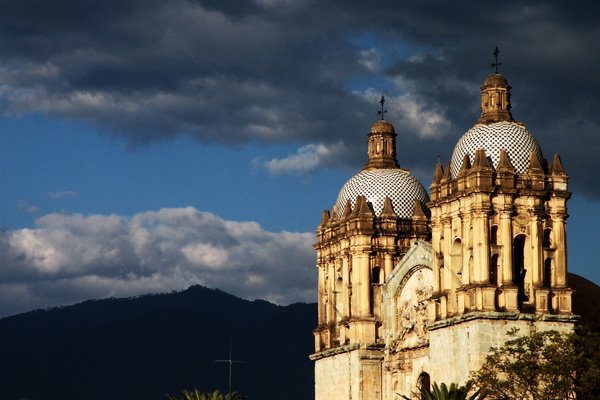For the dancers, it is a physical ordeal and yesterday, they were still going strong even though they had dance for close to ten hours the previous day. It is a lot of dancing and with the penachos, the headdresses, catching the wind and forcing them to keep their heads erect, well, they sure have earned my respect. I can't imagine it.
And the day and the dance itself are filled with special and powerful moments. Here is Moctezuma, Jose Isaac Vazques de los Angeles, with Malinche, Juana Lisabeth Contreras Vicente.
And here is the moment when Monctezuma takes off his penacho and hands to Doña Marina, Malinche's alter ego, Ailani Ruiz Ruiz. Great symbolism there.
Yesterday, was the first time, I really caught the significance of this moment. It gripped me.
It is food for thought on the history of Mexico. For many people here, Cortez was no hero and Doña Marina/Malinche represent a complex part of the Mexican psyche, malinchismo.
from Wikipedia
The word malinchismo is used by some modern-day Mexicans to refer pejoratively to those countrymen who prefer a different way of life from that of their local culture, or a life with other outside influences. Some historians believe that La Malinche saved her people from the Aztecs, who held a hegemony throughout the territory and demanded tribute from its inhabitants. Some Mexicans also credit her with having brought Christianity to the "New World" from Europe, and for having influenced Cortes to be more humane than he would otherwise have been. It is argued, however, that without her help, Cortes would not have been successful in conquering the Aztecs as quickly, giving the Aztec people enough time to adapt to new technology and methods of warfare. From that viewpoint, she is seen as one who betrayed the indigenous people by siding with the Spaniards. Recently a number of feminist Latinas have decried such a categorization as scapegoating, blaming her for forces beyond her contro
Octavio Paz addresses the issue of La Malinche's role as the mother of Mexican culture in The Labyrinth of Solitude. He uses her relation to Cortés symbolically to represent Mexican culture as originating from rape and violation. He uses the analogy that she essentially helped Cortés take over and destroy the Aztec state by submitting herself to him. His claim summarizes a major theme in the book, claiming that Mexican culture is a labyrinth.








4 comments:
Just discovered your blog. Enjoying reading the older posts. Viva Oaxaca!
Glad you are enjoying the older posts. I sure did.
I am really impressed with all the images , and I must say that even I am mexican, with your blog I am learning ,appreciating and enjoying all the traditions of this culture, of this part of my country. You capt the escence of the moment, and people. I didn´t know this "danza de las plumas "and its interpretation. La Malinche is a character of our history, that we learn in primary school, and she is no well seen in the official books ( well in my primary years, maybe now it has changed) she is described like a treacherous, and we grow with that image, until I grew up, that we begin to read more intelligently, and we begin to be aware about us ( the "why " of our culture and our social behavoir, more me like a woman). So la Malinche , as you well say , is the mother of this new culture, mexican culture, She is seen from a dichotomy, she can be seen like a virgin or like a mother raped. ( that thats how it was with all the ´women in the time of the conquest).Malinche really is the symbol of the Mestizaje, so that is what we are, we are not completly indigenous, we are not completly europeans, and the beauty of this is that we have done a rich fusion between two diferents cultures. And la Malinche is our reference of that syncretism. Maybe she did it because she didn´t has no option, maybe she did it for love.... ( I´ve been married twice, one with a spanish and one with a belge, a double Malinche)http://www.youtube.com/watch?v=oKjawPPuw-c
Gracias for the comment. The more I learn, the more realize there is to learn. I feel like I have barely scratched the surface. These are ancient, deep and sophisticated rituals and always, always, so beautiful and moving.
Malinche is such a fascinating woman, so complex.
Post a Comment